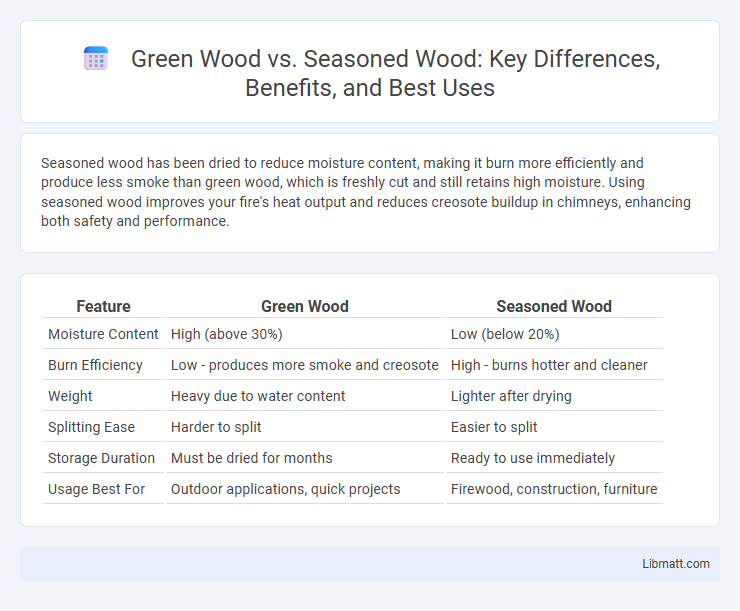Seasoned wood has been dried to reduce moisture content, making it burn more efficiently and produce less smoke than green wood, which is freshly cut and still retains high moisture. Using seasoned wood improves your fire's heat output and reduces creosote buildup in chimneys, enhancing both safety and performance.
Table of Comparison
| Feature | Green Wood | Seasoned Wood |
|---|---|---|
| Moisture Content | High (above 30%) | Low (below 20%) |
| Burn Efficiency | Low - produces more smoke and creosote | High - burns hotter and cleaner |
| Weight | Heavy due to water content | Lighter after drying |
| Splitting Ease | Harder to split | Easier to split |
| Storage Duration | Must be dried for months | Ready to use immediately |
| Usage Best For | Outdoor applications, quick projects | Firewood, construction, furniture |
Introduction to Green Wood and Seasoned Wood
Green wood contains high moisture content, making it heavier and prone to shrinking or warping as it dries, while seasoned wood has been dried naturally or kiln-dried to reduce moisture, ensuring better stability and improved burning efficiency. Your choice between green and seasoned wood significantly impacts heat output and smoke production during combustion. Understanding these differences helps optimize fuel performance for heating or woodworking projects.
Definition and Characteristics of Green Wood
Green wood refers to freshly cut timber that retains a high moisture content, often exceeding 50%, which makes it heavier and softer compared to seasoned wood. It typically displays a brighter color, sap presence, and a higher risk of warping, splitting, and shrinking as it dries. The moisture in green wood affects its burning efficiency, causing uneven combustion and increased smoke production.
Definition and Characteristics of Seasoned Wood
Seasoned wood refers to timber that has been dried naturally or through artificial methods to reduce its moisture content, typically below 20%. This drying process enhances the wood's stability, strength, and combustibility, making it ideal for construction and efficient burning in fireplaces. Compared to green wood, seasoned wood exhibits less cracking, warping, and shrinkage due to its lower water content.
Moisture Content Comparison
Green wood typically contains a moisture content ranging from 30% to 60%, making it significantly wetter and heavier compared to seasoned wood, which has a moisture content below 20%. This high moisture level in green wood leads to inefficient burning, smoke production, and creosote buildup. Seasoned wood, having undergone natural drying or kiln drying, burns hotter and cleaner due to its lower moisture content.
Burning Efficiency and Heat Output
Seasoned wood burns more efficiently than green wood due to its lower moisture content, which allows it to ignite quickly and sustain a hotter flame. Green wood contains high amounts of water that vaporize during burning, reducing heat output and producing more smoke and creosote buildup. For optimal heat output and efficient fuel use, your choice should favor well-seasoned wood over green wood.
Environmental Impact and Emissions
Green wood releases higher moisture content when burned, resulting in increased smoke, particulate matter, and harmful emissions such as carbon monoxide and volatile organic compounds. Seasoned wood, dried to a moisture content below 20%, burns more efficiently, reducing harmful emissions and minimizing its environmental footprint. Using seasoned wood supports cleaner air quality and more sustainable firewood consumption by lowering pollutant output.
Storage and Preparation Requirements
Green wood requires longer drying times and specialized covered storage to prevent moisture retention and decay, while seasoned wood benefits from well-ventilated, dry storage to maintain its low moisture content. Proper stacking and protection from rain and ground contact are essential for both types to ensure efficient drying and optimal burning performance. Seasoned wood typically needs less preparation before use, as it is already dried and ready for combustion.
Cost Differences and Availability
Green wood is generally less expensive due to its immediate availability and minimal processing requirements, making it a cost-effective option for buyers. Seasoned wood, having been dried and aged for months or even years, typically commands a higher price because of the labor and time involved in reducing its moisture content. Availability of green wood is widespread and consistent, while seasoned wood depends on supply chains that ensure proper storage and drying times, sometimes limiting accessibility.
Ideal Uses for Green and Seasoned Wood
Green wood, containing high moisture content, is ideal for tasks like carving, shaping, and certain types of smoking where slow drying enhances flavor. Seasoned wood, dried to a moisture level below 20%, is preferred for efficient burning in fireplaces, stoves, and outdoor fire pits due to its higher heat output and reduced smoke. Properly seasoned wood ensures cleaner combustion and less creosote buildup, making it essential for indoor heating and cooking.
Conclusion: Which Wood is Best for Your Needs?
Seasoned wood offers superior burning efficiency, lower moisture content, and less smoke compared to green wood, making it ideal for heating and cooking. Green wood, containing higher moisture, produces more smoke and creosote buildup, which can damage fireplaces and chimneys. For optimal safety and heat output, seasoned wood is generally the best choice for residential use.
Green wood vs Seasoned wood Infographic

 libmatt.com
libmatt.com